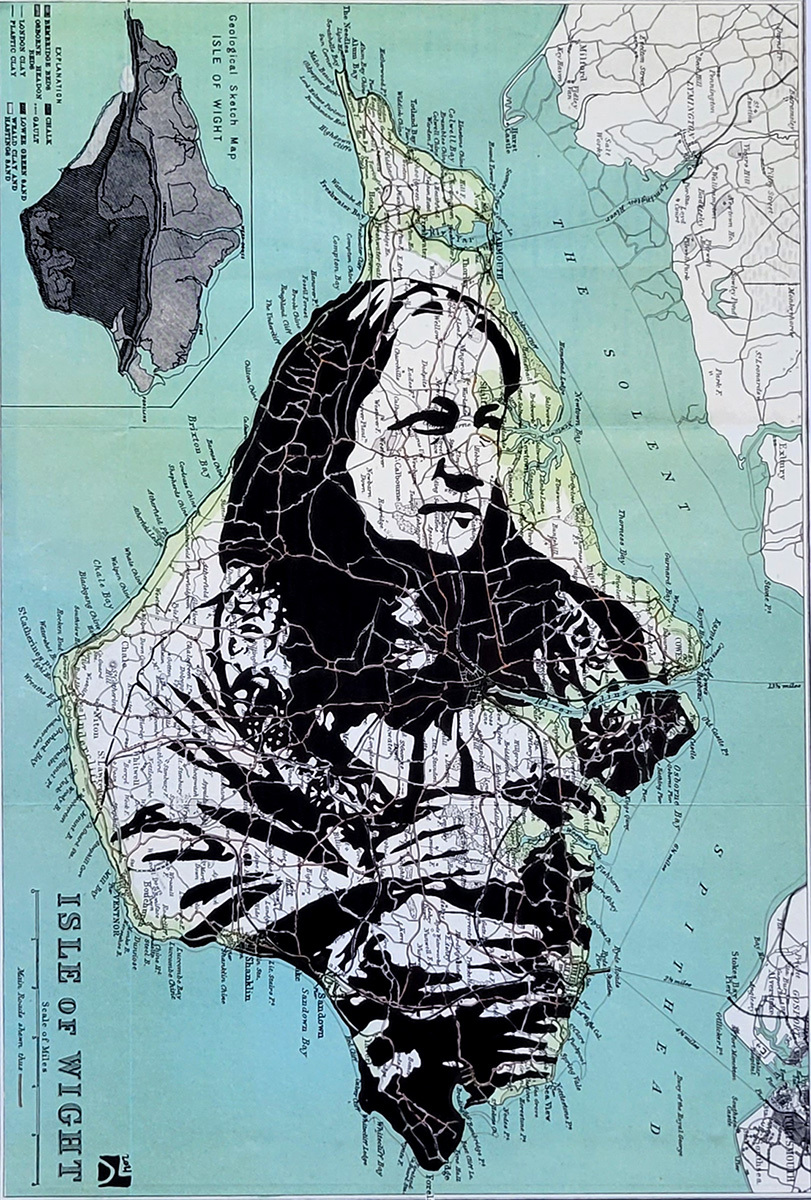
Tuesday Mar 22, 2022
Julia Margaret Cameron: Photography pioneer & inventor of the close-up portrait
“I longed to arrest all beauty that came before me.”
Julia Margaret Cameron
Photographer

The artwork:
Ink drawing on a map of the Island of Wight, UK, based on a self portrait by Julia Cameron. Her home in Freshwater is located on the left side, above her head.
The story:
Julia Cameron began career as a photographer relatively late at the age of 48, when she was given her first camera. A present from her daughter, the camera was meant to be a source of entertainment for Cameron at her UK home on the Isle of Wight while her husband tended to his coffee plantations in Sri Lanka. “It may amuse you, Mother, to try to photograph during your solitude,” said her daughter.
Cameron took to photography with gusto, learning her craft and focusing on making portraits in her studio converted from a chicken coop.
“Many and many a week in the year 1864, I worked fruitlessly, but not hopelessly… I began with no knowledge of the art. I did not know where to place my dark box, how to focus my sitter, and my first picture I effaced to my consternation by rubbing my hand over the filmy side of the glass,” she said of her photographic beginnings.
However, she did not stay “fruitless” for long and she quickly came to see her camera as, “A living thing, with voice, memory, and a creative vigor.”
Within a year, she was a member of the Photographic Societies of London and Scotland. She developed a unique style, characterized by close-cropped intimate portraits that were often deliberately slightly out of focus or blurred by her subjects moving during long exposures.
Highly unconventional for her day, her style was heavily criticized by the photography establishment during her lifetime for her supposedly poor technique. She is now recognized as one of Britain’s greatest portrait photographers of the 19th century and credited with creating the first close-up portraits in the history of the medium. Cameron dismissed the carping by her peers of her soft focus work, saying, “What is focus and who has the right to say what focus is the legitimate focus?”
Cameron’s photography career was short but productive. She made around 900 photographs over a 12-year period, registering each of them with the copyright office. Her subjects included luminaries from the London cultural scene, including Alfred Lord Tennyson, Robert Browning, Henry Wadsworth Longfellow, and Charles Darwin.
While her photos of eminent Victorian men featured strong contrasts in light and shadow (chiaroscuro) resulting in powerful images, her portraits of women are noted for their particularly sensitive and often delicate renderings of female beauty.
Describing her photography career, Cameron said, “I longed to arrest all the beauty that came before me and at length the longing has been satisfied. Its difficulty enhanced the value of the pursuit.”
Background on Cameron:
The daughter of an East India Company official, Cameron was born in India on June 11, 1815. She was educated with relatives in France and then she returned to India after completing her schooling. She met her husband, Charles Hay Cameron, while both of them were convalescing, likely from malaria. They married in Kolkata, two years after meeting.
Her photography was actively supported by her husband and she eagerly showed him every photograph she made:
“My husband from first to last has watched every picture with delight, and it is my daily habit to run to him with every glass upon which a fresh glory is newly stamped, and to listen to his enthusiastic applause. This habit of running into the dining-room with my wet pictures has stained such an immense quantity of table linen with nitrate of silver, indelible stains, that I should have been banished from any less indulgent household,” she said.
By all accounts, the Camerons were a happy couple, devoted to each other. They raised 11 children together, six of their own and five orphans they adopted. They moved to London in the 1840s and were an active part of the social and cultural scene. After visiting Tennyson’s home on the Isle of Wight, Cameron was taken with the location and they bought their own home on the island, calling it Dimbola Lodge.
She died on January 26, 1879 in Kalutara, Sri Lanka, where her husband held coffee plantations.
Music:
This episode contains music by Geovane Bruno and Michael Kobrin.
Sources:
- Cameron, J. M. (2016, February 15). 11 Quotes By Photographer Julia Margaret Cameron. John Paul Caponigro. https://www.johnpaulcaponigro.com/blog/16476/11-quotes-by-photographer-julia-margaret-cameron/
- Encyclopedia Britannica. (n.d.). Julia Margaret Cameron | British photographer. https://www.britannica.com/biography/Julia-Margaret-Cameron
- Photogpedia. (2021, March 21). 25 Timeless Julia Margaret Cameron Quotes to Bookmark. https://photogpedia.com/julia-margaret-cameron-quotes/
- Wikipedia contributors. (2021, November 7). Julia Margaret Cameron. Wikipedia. https://en.wikipedia.org/wiki/Julia_Margaret_Cameron
No comments yet. Be the first to say something!